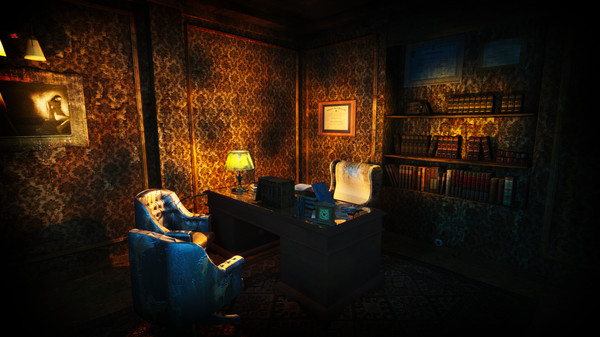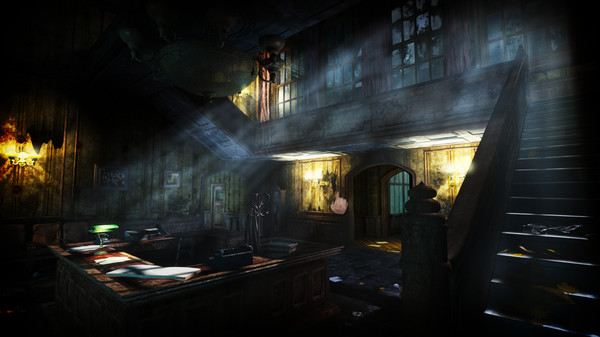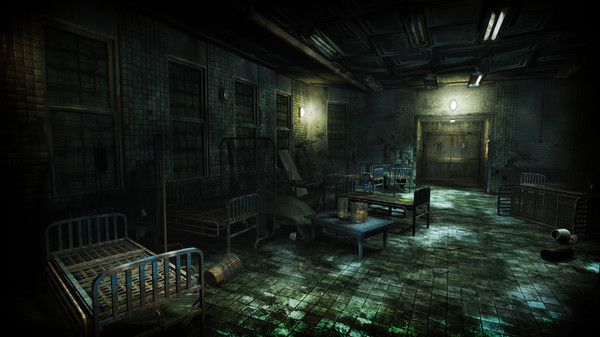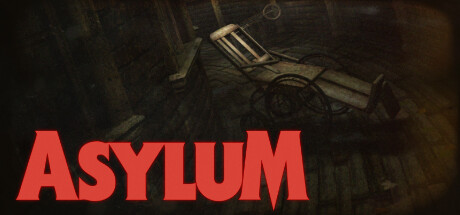Senscape's ASYLUM: Insanity as Vulnerability and Shield, and Inescapable Fate
 |
| Screenshot from the game, ASYLUM (2025). |
Senscape's ASYLUM: Insanity as Vulnerability or Shield, and Inescapable Fate
A Story Analysis a la Zombie March
Senscape's latest game release, ASYLUM, came out in mid-March. Since then, a huge number of loyal Senscape fans have played the game and have come out with their own thoughts and interpretations of the Lovecraftian horror. Theories abound in the bustling Senscape Discord community and on Steam forums, and I'm sure in a range of different online communities as well.
ASYLUM has been fresh in my mind for the last couple of weeks, percolating, simmering beneath the surface, while I go about my daily life. A part of me considered adding a last-minute case study to my horror writing course discussing some facet of the game - perhaps its application of the cosmic horror genre, or the way in which the game developers approached the concept of insanity - but thought better of it, on account of the fact that I wasn't entirely sure what I wanted to say about the game just yet.
After taking these past couple of weeks to really let the full story sit in my mind, I think I've come to certain conclusions - or, at least, have developed viable theories - regarding the game's narrative. I'm going to talk about only two of them in this article: the ways in which insanity is presented as both a vulnerability and a protective element, and the ways in which the narrative of the game creates an inescapable destiny that the protagonist cannot turn away from.
Horror writing topics: story structure, character development, metaphor, setting, insanity as concept. Last updated April 3, 2025.
In accordance to the wishes of the Senscape team, who do not want players to be spoiled before experiencing the game on their own, I must warn you.
This story analysis will have SPOILERS.
A full analysis of the game requires a full understanding of the game - including its ending and the many reveals made throughout the gameplay experience.
If you have not played the game, and want to play the game, please bookmark this for reading afterwards. Maybe you'll have your own juicy theories to chip in with!
Head on over to the Steam page and find the game there.
Happy gaming!
Okay?
All clear, all green, all good to go?
With that out of the way, let's begin our vivisection.
 |
| Screenshot from ASYLUM (2025). |
Insanity as Protection and Weakness
Insanity is portrayed in two opposing ways in ASYLUM. On the one hand, those who are mentally unwell, such as the members of Group E, are found to be particularly receptive to the entity below. This is explored in the game and discussed in various documents, and I won't be going into too much detail here. On the other hand, we have our protagonist - the player character - who is also arguably insane. My theory is that none of the characters we meet in the Hanwell Institute are real people, but rather manifestations of the protagonist's mind.
Consider the odd situation we find ourselves in:
It's night time. We're at the Hanwell Institute; there seems to be nobody else there from the outside. The place looks like it's been left abandoned for decades, which we know couldn't possibly be the case through context clues that we find throughout the story of the game.
Inside, we meet Julia, a receptionist that has apparently been posted in this abandoned, run-down, unsafe-for-working environment before renovations begin. And there's Bruno, the security guard who has also been posted in this abandoned, run-down, unsafe-for-work environment to monitor certain patients who have already been sent to stay in this ABANDONED, RUN-DOWN, UNSAFE ENVIRONMENT. Later on, we also meet Dr. Miller, who is hard at work in this - did I mention it was an abandoned, run-down, unsafe-for-working environment? I did? Oh.
It doesn't make sense. Right off the bat, it doesn't make any sense. There is no way patients would be sent to stay in the Hanwell Institute while it's in this sorry state, let alone employees. Most players find it jarring and odd right from the start, and it seems to be purposefully designed to elicit this reaction. So, what's really going on here?
My theory is that each of these characters represent a certain facet of the player character's mental state. (I should also note that they could simply be hallucinations, given that there seems to be a hallucinogenic quality to the mold that grows from the entity below, and who's to say it can't control what a person sees when hallucinating?)
Julia
For example, Julia seems to be the voice of reason, a stable no-nonsense presence in the institute that provides limited guidance. The symbolism of the ending - the gouging of the eyes - is one that could represent the protagonist's loss of sanity and reason now that they have succeeded in their goal. In a Lovecraftian sense, it could also represent the inhuman nature of the protagonist, if we assume that the entity has taken possession of his body by that point in the story, and thus the gouging of the eyes could simply be a metaphor for the throwing aside of human reasoning and rationality. These are things the monster has no need for, and probably doesn't understand at all. At this time, Julia is also the last remaining manifestation of the protagonist's mind - the last part of him. By gouging her eyes out, he's throwing aside that last vestige of the protagonist's mind or humanity.
Bruno and the High-Risk Patient
What about the security guard, Bruno, then? Bruno is the one trying to keep the patients in their cells - in particular that one dangerous patient that often breaks out and runs around violently. But Bruno doesn't really like his job; he wants this posting to be over already. This part of Bruno's personality may represent the inner-most desires of the protagonist to accept the irrationality and madness that comes with knowing the monster, despite his mind doing its best to keep such madness (represented by the patient) at bay. This conflict is further highlighted by the records: Bruno's insistence on keeping the record away instead of playing it to soothe the violent patient could represent the mind's fragile hold on its sanity, fueled by the protagonist's then-hidden desires to chase insanity. The more the protagonist investigates the Hanwell Institute and learns about himself and what was happening within the asylum, the less we see of Bruno, until finally he simply disappears, signalling the protagonist's mental transformation.
Lenny
Lenny is a tricky one, despite obviously being such a critical component in the story. I want to say that he's the last vestige of the protagonist's guilt or remorse, but it's hard to think that our player character has any remorse for any of the things he's done (more about who the protagonist is in the next section). So, if we assume that Lenny is not a manifestation of the protagonist's guilt or remorse, what else could he be?
There's a chance that Lenny is the manifestation of the self-identified fate that the protagonist is heading towards. He's a representation of everything that the protagonist knows, deep down, beyond the amnesia. Lenny is equal parts warning and encouragement, however. He warns the protagonist against digging any deeper into the lore and history of the Hanwell Institute, reluctant to provide any information, but becomes more open the more we learn about the institute and what happens there. Later on he seems to almost encourage us in the tunnels the last time we see him.
In fact, the last time we see Lenny, he's very different. He's calmer, more determined, and tells the protagonist that "The time has come... Now you must proceed." Is this the same Lenny we saw earlier, who didn't even want to discuss what was happening down in the tunnels? I don't think so. I think, by this time, the protagonist is ready to meet the entity below, and thus ready to throw away his sanity and humanity; thus, the manifestations in his mind change drastically. Lenny isn't the warning!Lenny anymore; this time, he's the one encouraging you to go on and meet your fate.
More than game mechanics
Some have argued that the characters you meet in the asylum are there for two main reasons: to help guide you by giving you hints, and to block you from progressing too early in the game. While they certainly do fulfill these roles from a mechanical perspective, I see that as only reinforcing the idea that they are manifestations of your mind. Just like we mentioned with Bruno, when these characters disappear, it's like another layer of humanity or rationality or resistance to the monster, "Phalote", also disappears with them. When they're all but gone, Phalote seemingly possesses Hanwell's body. All that's left is Julia - and she needs to go, too, so that he can have absolute control of this new vessel. (Either that, or Hanwell's second meeting with Phalote leaves him without memories again and with a few more screws loose.)
With every "roadblock" that is lifted (Lenny's cart disappearing once again, for example, or him finally giving us the key to Hanwell's office - late enough in the story that the protagonist is potentially more prepared to learn more about himself), and with every character who completely disappears, another blindfold is removed from the protagonist's mind, bringing him closer to his own identity - and back to his original self.
In this way, we can also think of the characters as milestones in the evolution of the player's perception of the character. In one of my lessons I discuss how you can have character development that is less about how the character changes throughout the course of the story and more about how the reader's perception of the character changes throughout the course of the story. Hanwell - if we are, indeed, playing as Hanwell - is an example of this kind of character development.
Any player would probably think that the protagonist is a decent enough guy; someone understandably frustrated by his lost memories and - as the story unfolds - frustrated by what he finds out about his condition. But the protagonist becomes more and more mysterious and unreliable when we realize that he couldn't have been one of the Group E patients, because there is no additional patient whose fate we haven't learned about, and the flashes of memory that we're exposed to place the protagonist in situations he couldn't have been in - as a patient.
We begin to consider the worst: he was one of the doctors, one of the very men who were in charge of Group E's forced labor and torture. We can expect that he'd be horrified to learn all of this about himself, but it's never clear whether the protagonist makes the connection or not. If he does, the lack of reaction is telling. I've seen a few players argue that they would have liked a story that
focused more on the horrific emotional journey of the player character
realizing that he was the main one responsible for so much suffering and
torture - and death - but I think the muted response is simply a
representation that he is returning to himself - that same, familiar,
cold, calculating, horrible person he always was.
It isn't that Hanwell is a changed man at the end of the story - it's that we finally can understand who we've been playing as this entire time - in whose mind we've been stuck in - on whose path we've been treading. (Something something rebirth is a big concept here.) Speaking of paths and being stuck, this brings me to my next note on the narrative structure of the game's story.
 |
| Screenshot from ASYLUM (2025). |
Destined Fate: Trapped in Who We Are
Dr. Hanwell - the player character - is seeking answers. He wants to know why he can't remember. He wants to know who he was - what he was doing here, at the Hanwell Institute - and what terrible thing happened. Of equal importance, Hanwell wants to know what's happening to him. On various occasions he states that he is feeling unwell, and at some point he is able to confirm that by performing a dangerous medical procedure on his own brain.
The story is linear; apart from missing out on pieces of lore or some dialogue options that you can unlock with the characters you interact with, everything that happens happens in a linear function. There is no other way to play the story: you must explore the asylum, figure out what's happening in your brain, eventually find your way into the tunnels, come face-to-face with the monster below, and undergo your final transformation.
There is an inescapable element to the linear narrative we are trapped in as the player. We must complete certain tasks that we may not want to complete; and had we had different options, we may not have made those decisions. The story isn't about what we want, though. We're playing through the protagonist's perspective. He drives the story; we just accomplish the tasks required to get him where he wants to go.
So, he wants to do a brain biopsy? Guess we're doing a brain biopsy.
He wants to trap the raging inmate? Guess we're trapping the raging inmate.
He wants to venture into the tunnels and see the monster? Guess we're going to see the monster.
We don't have a choice.
But, I would argue, neither does our protagonist.
Our protagonist doesn't have a choice because this is who he is. As we learn at the end of the game, the player character we've been playing with this whole time is Dr. Hanwell - the very same man who was forcing Group E into hard labor despite having in his colleague a proven methodology for improving their mental state. The same man who was using them as disposable lab rats to learn more about the entity below. The same man who probably played a huge role in refusing Rebecca's request for an abortion and later gave her baby to the monster.
And it all falls into place.
Like Oedipus, Hanwell is doomed to make the mistakes that he was always going to make. Even after losing all of his memories, he is still the same person he always was. Always seeking that knowledge which is forbidden to him, always sacrificing those around him to do so, always going to extreme lengths to get what he wants. Always allowing his own pride and greed to eclipse all other concerns.
In the words of Morpheus, "What happened happened, and could not have happened any other way." Like a comet hurtling towards its target, Hanwell is making his way to the monster below, one hour at a time.
In this way, we can also consider everything we've just learned about the characters-as-manifestations. If none of them are real - patients included - then there's nothing in the Hanwell Institute that can harm Hanwell. The entire construct - everything he sees in the building, everything he experiences - is simply his mind's way of leading him out of the labyrinth of his amnesia and re-setting itself, so that he can finally accomplish his true and original goal: Becoming a vessel for the Lovecraftian entity.
Or, perhaps, is it something different? Is it that, just like the town in Silent Hill 2 called to James, the entity and Hanwell Institute called to Hanwell, bringing him there with motives of its own?
Speaking of Silent Hill 2...
In Silent Hill 2, the town of Silent Hill has some kind of power that allows it to manifest differently for different people. There's obviously a physical town there, but different people who are called to Silent Hill see the town differently. In James's perspective (the player character), Silent Hill is a grimy, run-down, desolate place full of monsters. But we know that other characters don't view the town in the same way; they don't have to deal with the monsters that James deals with, though they have their own demons to contend with. Some have noted that there might be something in the fog that causes these hallucinations, these illusory worlds - but the nature of Silent Hill, which forces people to face their traumas, necessitates some kind of intelligent control, so there's an element of the supernatural - the setting as something that makes decisions, that acts on the characters, that has agency on its own.
Similarly, we can consider the mold growing in Hanwell Institute, which seems to have hallucinogenic properties, and which also leads to the growth of tumors in the brain - and, as we know, tumors in the brain can make the brain behave in very odd ways. It doesn't seem too much of a stretch to think that Hanwell Institute is a setting that can be "alive", perceived in different ways by different people. Consider, for example, how surprised Dr. Miller is when the protagonist mentions how filthy the place is. He seems a little indignant, as if it's not that bad. But we have eyes; we can see how filthy and grimy and disgusting the setting is. Or... is it? Is this simply how our protagonist perceives the place to look?
(Okay - you got me. You're probably thinking, But wait, didn't we just say that the characters aren't real? And yes, we did. Dr. Miller, through that lens, would be the protagonist's subconscious mind dropping the hint that what you're really seeing is not what you think you're seeing.)
If it really is just a matter of hijacked perception, then what else has the mold's hallucinogenic and carcinogenic powers - which we can assume are somehow controlled by Phalote - shown us? The characters, as we've already talked about (like Silent Hill 2's Maria). The information that we find - is it really there? Did someone really just leave a bunch of documents about Hanwell Institute lying around in this abandoned place? Are the corpses of the dead patients also just hallucinations? (It has been mentioned that it's odd they haven't decomposed yet.)
It seems to me that understanding the story in this way does provide us with a framework that can explain most of the big questions that the players have by the end of the story. What happened to Bruno? Why did we do that to Julia? How did Lenny get into the tunnel in the end? Why are there patients in this decrepit place? Why is there anyone in this place at all?
It's all in the glowing mold.
(By the way, there's a whole case study lesson dedicated to Silent Hill 2 in Zombie March. Just putting that out there.)
Final Thoughts
There's so much more I'd like to get into: the Unit System and how architecture affects mental health - a core theme in the game that I'm excited to pick apart using the concept of labyrinth and isolation; the role of Rebecca in the story and how it can be understood in contemporary context (women's rights, abortion laws, male interference, etc.); birth/re-birth and life/death dichotomies in the story; and alternative interpretations of some of the game story elements I've discussed in this post.
I'm also planning to analyze various other movies, books, stories, and video games in a similar way, so if that's something you enjoy reading, keep an eye on this space; you'll soon have some juicy horror analysis to chew over.
If you want to get to a point where you can analyze horror stories, break them down and interpret them through various different perspectives and lenses, this is one of the skills taught through my horror writing course, Zombie March. It's a critical skill for horror writers who want to craft powerful and lingering horror stories, and it's only one of many different techniques and skills taught in the course.



Comments
Post a Comment
Share your thoughts in the comments section!